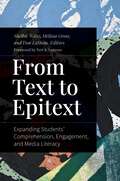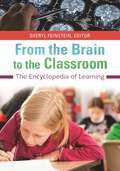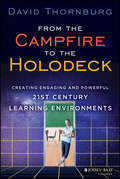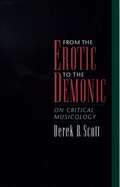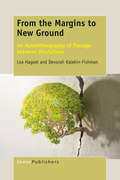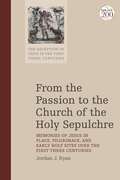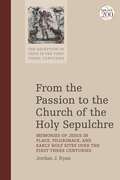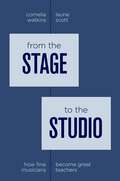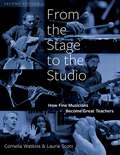- Table View
- List View
From Text to Epitext: Expanding Students' Comprehension, Engagement, and Media Literacy
by Shelbie Witte, et al.This volume explains how analyzing textual elements that aren't part of the text but connected to it can be used with K–16 students to improve comprehension, engagement, critical thinking, and media literacy.Beginning with an introduction that briefly explains Genette's theory of paratext and discusses the functions of epitext theory, this book comprises theory-to-practice chapters that showcase ways in which teachers and librarians can use elements independent of a text to discuss texts and media with students. Chapters include a practitioner's section specifying practical approaches and explanations for how to use epitext.Scaffolding an application of theory to practice, this title provides educators with an original approach to increasing literacy engagement and integration as well as for increasing media literacy and critical thinking. It includes practical ideas for using epitext in the classroom to promote critical thinking and for collaboration between teachers and librarians. It also includes editorial sidebars that provide additional "how-to" ideas, support deep thinking, make connections to relevant content in other chapters, and provide examples for students in K–16 classrooms.
From Text to Epitext: Expanding Students' Comprehension, Engagement, and Media Literacy
by Shelbie Witte Melissa Gross Don Latham Teri S. LesesneThis volume explains how analyzing textual elements that aren't part of the text but connected to it can be used with K–16 students to improve comprehension, engagement, critical thinking, and media literacy.Beginning with an introduction that briefly explains Genette's theory of paratext and discusses the functions of epitext theory, this book comprises theory-to-practice chapters that showcase ways in which teachers and librarians can use elements independent of a text to discuss texts and media with students. Chapters include a practitioner's section specifying practical approaches and explanations for how to use epitext.Scaffolding an application of theory to practice, this title provides educators with an original approach to increasing literacy engagement and integration as well as for increasing media literacy and critical thinking. It includes practical ideas for using epitext in the classroom to promote critical thinking and for collaboration between teachers and librarians. It also includes editorial sidebars that provide additional "how-to" ideas, support deep thinking, make connections to relevant content in other chapters, and provide examples for students in K–16 classrooms.
From Text to 'Lived' Resources: Mathematics Curriculum Materials and Teacher Development (Mathematics Teacher Education #7)
by Ghislaine Gueudet, Birgit Pepin and Luc TroucheWhat kinds of curriculum materials do mathematics teachers select and use, and how? This question is complex, in a period of deep evolutions of teaching resources, with the proficiency of online resources in particular. How do teachers learn from these materials, and in which ways do they ‘tailor’ them for their use and pupil learning? Teachers collect resources, select, transform, share, implement, and revise them. Drawing from the French term « ingénierie documentaire »,we call these processes « documentation ». The literal English translation is « to work with documents », but the meaning it carries is richer. Documentation refers to the complex and interactive ways that teachers work with resources; in-class and out-of-class, individually, but also collectively.
From Texting to Teaching: Grammar Instruction in a Digital Age
by Jeremy Hyler Troy HicksDon’t blame technology for poor student grammar; instead, use technology intentionally to reach students and actually improve their writing! In this practical book, bestselling authors Jeremy Hyler and Troy Hicks reveal how digital tools and social media – a natural part of students’ lives – can make grammar instruction more authentic, relevant, and effective in today’s world. Topics Covered: Teaching students to code switch and differentiate between formal and informal sentence styles Using flipped lessons to teach the parts of speech and help students build their own grammar guides Enlivening vocabulary instruction with student-produced video Helping students master capitalization and punctuation in different digital contexts Each chapter contains examples, screenshots, and instructions to help you implement the ideas. With the strategies in this book, you can empower students to become better writers with the tools they already love and use daily. Additional resources and links are available on the book’s companion wiki site: textingtoteaching.wikispaces.com
From Texting to Teaching: Grammar Instruction in a Digital Age
by Jeremy Hyler Troy HicksDon’t blame technology for poor student grammar; instead, use technology intentionally to reach students and actually improve their writing! In this practical book, bestselling authors Jeremy Hyler and Troy Hicks reveal how digital tools and social media – a natural part of students’ lives – can make grammar instruction more authentic, relevant, and effective in today’s world. Topics Covered: Teaching students to code switch and differentiate between formal and informal sentence styles Using flipped lessons to teach the parts of speech and help students build their own grammar guides Enlivening vocabulary instruction with student-produced video Helping students master capitalization and punctuation in different digital contexts Each chapter contains examples, screenshots, and instructions to help you implement the ideas. With the strategies in this book, you can empower students to become better writers with the tools they already love and use daily. Additional resources and links are available on the book’s companion wiki site: textingtoteaching.wikispaces.com
From the Brain to the Classroom: The Encyclopedia of Learning
by Sheryl FeinsteinSupplying a foundation for understanding the development of the brain and the learning process, this text examines the physical and environmental factors that influence how we acquire and retain information throughout our lives. The book also lays out practical strategies that educators can take directly into the classroom.Comprising more than 100 entries, From the Brain to the Classroom: The Encyclopedia of Learning gathers experts in the fields of education, neuroscience, and psychology to examine how specific areas of the brain work in thought processes, and identifies how educators can apply what neuroscience has discovered to refine their teaching and instructional techniques. The wide range of subjects—organized within the main categories of student characteristics, classroom instructional topics, and learning challenges—include at-risk behaviors; cognitive neuroscience; autism; the lifespan of the brain, from prenatal brain development to the aging brain; technology-based learning tools; and addiction. Any reader who is interested in learning about how the brain works and how it relates to everyday life will find this work fascinating, while educators will find this book particularly helpful in validating or improving their teaching methods to increase academic achievement.
From the Brain to the Classroom: The Encyclopedia of Learning
by Sheryl FeinsteinSupplying a foundation for understanding the development of the brain and the learning process, this text examines the physical and environmental factors that influence how we acquire and retain information throughout our lives. The book also lays out practical strategies that educators can take directly into the classroom.Comprising more than 100 entries, From the Brain to the Classroom: The Encyclopedia of Learning gathers experts in the fields of education, neuroscience, and psychology to examine how specific areas of the brain work in thought processes, and identifies how educators can apply what neuroscience has discovered to refine their teaching and instructional techniques. The wide range of subjects—organized within the main categories of student characteristics, classroom instructional topics, and learning challenges—include at-risk behaviors; cognitive neuroscience; autism; the lifespan of the brain, from prenatal brain development to the aging brain; technology-based learning tools; and addiction. Any reader who is interested in learning about how the brain works and how it relates to everyday life will find this work fascinating, while educators will find this book particularly helpful in validating or improving their teaching methods to increase academic achievement.
From the Brain to the Mouth: Acquired Dysarthria and Dysfluency in Adults (Neuropsychology and Cognition #12)
by Yvan LebrunFrom the Campfire to the Holodeck: Creating Engaging and Powerful 21st Century Learning Environments
by David ThornburgHow to optimize educational spaces and teaching practices for more effective learning Author David Thornburg, an award-winning futurist and educational consultant, maintains that in order to engage all students, learning institutions should offer a balance of Campfire spaces (home of the lecture), Watering Holes (home to conversations between peers), Caves (places for quiet reflection), and Life (places where students can apply what they've learned). In order to effectively use technology in the classroom, prepare students for future careers, and incorporate project-based learning, all teachers should be moving from acting as the "sage on the stage" to becoming the "guide on the side." Whether you are a school administrator interested in redesigning your school or a teacher who wants to prepare better lessons, From the Campfire to the Holodeck can help by providing insight on how to: Boost student engagement Enable project-based learning Incorporate technology into the classroom Encourage student-led learning From the Campfire to the Holodeck is designed to help schools move from traditional lecture halls (Campfires) where students just receive information to schools that encourage immersive student-centered learning experiences (Holodecks).
From the Campfire to the Holodeck: Creating Engaging and Powerful 21st Century Learning Environments
by David ThornburgHow to optimize educational spaces and teaching practices for more effective learning Author David Thornburg, an award-winning futurist and educational consultant, maintains that in order to engage all students, learning institutions should offer a balance of Campfire spaces (home of the lecture), Watering Holes (home to conversations between peers), Caves (places for quiet reflection), and Life (places where students can apply what they've learned). In order to effectively use technology in the classroom, prepare students for future careers, and incorporate project-based learning, all teachers should be moving from acting as the "sage on the stage" to becoming the "guide on the side." Whether you are a school administrator interested in redesigning your school or a teacher who wants to prepare better lessons, From the Campfire to the Holodeck can help by providing insight on how to: Boost student engagement Enable project-based learning Incorporate technology into the classroom Encourage student-led learning From the Campfire to the Holodeck is designed to help schools move from traditional lecture halls (Campfires) where students just receive information to schools that encourage immersive student-centered learning experiences (Holodecks).
From the Confucian Way to Collaborative Knowledge Co-Construction: New Directions for Teaching and Learning, Number 142 (J-B TL Single Issue Teaching and Learning)
by Gertina J. van Schalkwyk Rik Carl D'AmatoSharing and engaging in interactions and discussion as required for collaborative teaching and learning can be a foreign concept to students coming from Asia or growing up in an Asian family. As such, this first volume in a two-volume edition helps lecturers, educators, and teachers create collaborative teaching and learning experiences with multicultural adult learners in higher education. Topics include: • assessment and evaluation techniques that focus on collaborative teaching and learning with diverse students, • students’ cultural beliefs and strategies for outcomes-based collaborative teaching and learning in Asia, and • an understanding of the unique learning motivations of contemporary Asian students. This is the 142nd volume of this Jossey-Bass higher education series. It offers a comprehensive range of ideas and techniques for improving college teaching based on the experience of seasoned instructors and the latest findings of educational and psychological researchers.
From the Confucian Way to Collaborative Knowledge Co-Construction: New Directions for Teaching and Learning, Number 142 (J-B TL Single Issue Teaching and Learning)
by Gertina J. Van Schalkwyk Rik Carl D'AmatoSharing and engaging in interactions and discussion as required for collaborative teaching and learning can be a foreign concept to students coming from Asia or growing up in an Asian family. As such, this first volume in a two-volume edition helps lecturers, educators, and teachers create collaborative teaching and learning experiences with multicultural adult learners in higher education. Topics include: • assessment and evaluation techniques that focus on collaborative teaching and learning with diverse students, • students’ cultural beliefs and strategies for outcomes-based collaborative teaching and learning in Asia, and • an understanding of the unique learning motivations of contemporary Asian students. This is the 142nd volume of this Jossey-Bass higher education series. It offers a comprehensive range of ideas and techniques for improving college teaching based on the experience of seasoned instructors and the latest findings of educational and psychological researchers.
From the Erotic to the Demonic: On Critical Musicology
by Derek B. ScottFrom the Erotic to the Demonic demonstrates how different musical styles construct ideas of class, sexuality, and ethnic identity. This book will serve as a model for musicologists who want to take a postmodern approach to their inquiries. The clear and lively arguments are supported by ninety musical examples taken from such diverse sources as opera, symphonic music, jazz, and nineteenth- and twentieth-century popular songs. Derek Scott offers new insights on a range of "high" and "low" musical styles, and the cultures that produced them.
From the Erotic to the Demonic: On Critical Musicology
by Derek B. ScottFrom the Erotic to the Demonic demonstrates how different musical styles construct ideas of class, sexuality, and ethnic identity. This book will serve as a model for musicologists who want to take a postmodern approach to their inquiries. The clear and lively arguments are supported by ninety musical examples taken from such diverse sources as opera, symphonic music, jazz, and nineteenth- and twentieth-century popular songs. Derek Scott offers new insights on a range of "high" and "low" musical styles, and the cultures that produced them.
From the Eye of the Storm: Higher Education's Changing Institution
by B. W. Jongbloed P. A. Maassen G. NeaveIn order to celebrate the fifteenth anniversary - the third lustrum - of our Center, we at CHEPS decided to collectively write a book on the issue of how higher education institutions deal with the demand for change. Institutional change is without any doubt one of the burning issues for researchers in higher education and policy studies in general, but even more so for administrators at the institutional level (institutional leadership, deans) and planners of higher education in public life (government agencies, intermediary organisations, international organisations). Whereas the lustrumbook we wrote for our second lustrum concentrated on comparative policy studies, many of them focusing on comparisons between different national higher education systems, this time the object of our analyses is the institution itself. Today's higher education institutions are faced by demands from a multitude of actors - from inside the institution (students, staff) as well as from the institution's environment (governments, employers, research councils, sponsors). These demands require changes in policy, practice, systems, and culture. The ways in which institutions respond to these demands and how their behaviour may be understood and predicted is the challenge tackled by the authors of this volume, each from their own perspective and each looking at different aspects of the educational organisation.
From the Golden Rectangle to the Fibonacci Sequences (Springer Texts in Education)
by Opher Liba Bat-Sheva IlanyThe book takes us on a fascinating journey through one of the most beautiful and fascinating topics of mathematics. It presents a wealth of information about the golden ratio and the Fibonacci sequence. The book introduces the reader to novel perspectives to classic mathematical concepts and problems. The book’s structure engages with the reader actively, leading to more profound understanding, satisfaction and deep insights in learning mathematics. The book strengthens and expands the readers' mathematical knowledge, allowing them a glimpse of several advanced academic concepts. It demonstrates and instils the essence of mathematical research, along the lines of George Polya: observation, conjecture, proof, implementation, generalization and raising new questions.
From the Laboratory to the Classroom: Translating Science of Learning for Teachers
by John Hattie Jared Cooney Horvath Jason M. LodgeOver recent years the field of Science of Learning has increased dramatically. Unfortunately, despite claims that this work will greatly impact education, very little research makes it into teacher practice. Although the reasons for this are varied, a primary concern is the lack of a proper translation framework. From the Laboratory to the Classroom aims to consolidate information from many different research disciplines and correlate learning principles with known classroom practices in order to establish explanatory foundations for successful strategies that can be implemented into the classroom. It combines theoretical research with the diverse and dynamic classroom environment to deliver original, effective and specific teaching and learning strategies and address questions concerning what possible mechanisms are at play as people learn. Divided into five sections, chapters cover: A Framework for Organizing and Translating Science of Learning Research Motivation and Attention as Foundations for Student Learning Memory and Metamemory Considerations in the Instruction of Human Beings Science of Learning in Digital Learning Environments Educational Approaches for Students Experiencing Learning Difficulties and Developmental Characteristics of Gifted Children Brain, Behaviour and Classroom Practice Forging Research/Practice Relationships via Laboratory Schools This fascinating text gathers an international team of expert scientists, teachers, and administrators to present a coherent framework for the vital translation of laboratory research for educational practice. Applying the Science of Learning framework to a number of different educational domains, it will be an essential guide for any student or researcher in education, educational psychology, neuropsychology, educational technology and the emergent field of neuroeducation.
From the Laboratory to the Classroom: Translating Science of Learning for Teachers
by John Hattie Jared Cooney Horvath Jason M. LodgeOver recent years the field of Science of Learning has increased dramatically. Unfortunately, despite claims that this work will greatly impact education, very little research makes it into teacher practice. Although the reasons for this are varied, a primary concern is the lack of a proper translation framework. From the Laboratory to the Classroom aims to consolidate information from many different research disciplines and correlate learning principles with known classroom practices in order to establish explanatory foundations for successful strategies that can be implemented into the classroom. It combines theoretical research with the diverse and dynamic classroom environment to deliver original, effective and specific teaching and learning strategies and address questions concerning what possible mechanisms are at play as people learn. Divided into five sections, chapters cover: A Framework for Organizing and Translating Science of Learning Research Motivation and Attention as Foundations for Student Learning Memory and Metamemory Considerations in the Instruction of Human Beings Science of Learning in Digital Learning Environments Educational Approaches for Students Experiencing Learning Difficulties and Developmental Characteristics of Gifted Children Brain, Behaviour and Classroom Practice Forging Research/Practice Relationships via Laboratory Schools This fascinating text gathers an international team of expert scientists, teachers, and administrators to present a coherent framework for the vital translation of laboratory research for educational practice. Applying the Science of Learning framework to a number of different educational domains, it will be an essential guide for any student or researcher in education, educational psychology, neuropsychology, educational technology and the emergent field of neuroeducation.
From the Margins to New Ground: An Autoethnography of Passage between Disciplines
by Lea Hagoel Devorah Kalekin-FishmanThe authors, two sociologists, discover, follow-up, examine, and make sense of the cross-roads where the social and life sciences meet, surprised by the emergent story which they simultaneously witness and document. Together, they focus on Lea Hagoel’s professional path as a medical sociologist fitting in with bio-medical scientific work patterns of a multi-disciplinary team of physicians, nurses, bio-statisticians, IT personnel, molecular biologists, and managerial-administrative team members. Lea shared her experiences with Devorah, and what developed into this book consists of the story itself – the unfolding of events as observed and described by Lea who tells what it was like for a sociologist. Her story unfolds in the context of the ongoing dialogue which lasted more than two decades and turned into an autoethnography à deux. Finally, the ethnographers offer insights into the world of biology and medicine, into women’s lives, into being a native in a disciplinary culture, and into transdisciplinarity. In three parts, the book describes and theorizes the quest of a medical sociologist for transdisciplinarity. Part I explores the theoretical background, Part II presents the story of different stages in Lea’s experiences tracing the trajectory of her growing professional repertoire and discovering the practical meaning of how cross-disciplinary knowledge affects her performance as a researcher in the organization with which she is affiliated. Part III draws conclusions about what moving between disciplines can mean for a researcher.
From the Page to the Stage: The Educator's Complete Guide to Readers Theatre (Readers Theatre)
by Shirlee SloyerReaders theatre is a powerful tool for building language skills and involving young readers with literature. Educator and seasoned readers-theatre coach Shirlee Sloyer provides teachers and librarians with nuts-and-bolts guidelines for integrating readers theatre into the classroom and library. Detailed instructions for every step guide readers through the process of setting up and conducting a successful program that is based on NCTE and IRA standards. Grades 4-8Includes: • An Overview of Readers Theatre• Selecting the Literature• Exploring Key Literary Elements• Compiling and Adapting Material• Classroom Procedures• Preparing for Performance• The Performance and Afterward• A Model Program and Script• 11 Classroom-Ready Sample Scripts
From the Passion to the Church of the Holy Sepulchre: Memories of Jesus in Place, Pilgrimage, and Early Holy Sites Over the First Three Centuries (The Reception of Jesus in the First Three Centuries)
by Jordan J. RyanSince the early 4th century, Christian pilgrims and visitors to Judea and Galilee have worshipped at and been inspired by monumental churches erected at sites traditionally connected with the life and ministry of Jesus of Nazareth. This book examines the history and archaeology of early Christian holy sites and traditions connected with specific places in order to understand them as interpretations of Jesus and to explore them as instantiations of memories of him. Ryan's overarching aim is to construe these places as instantiations of what historian Pierre Nora has called “lieux de mémoires,” sites where memory crystallizes and, where possible, to track the course and development of the traditions underlying them from their genesis in the Gospel narratives to their eventual solidification in the form of pilgrimage sites. So doing will bring rarely considered evidence to the study of early Christian memory, which in turn helps to illuminate the person of Jesus himself in both history and reception.
From the Passion to the Church of the Holy Sepulchre: Memories of Jesus in Place, Pilgrimage, and Early Holy Sites Over the First Three Centuries (The Reception of Jesus in the First Three Centuries #7)
by Jordan J. RyanSince the early 4th century, Christian pilgrims and visitors to Judea and Galilee have worshipped at and been inspired by monumental churches erected at sites traditionally connected with the life and ministry of Jesus of Nazareth. This book examines the history and archaeology of early Christian holy sites and traditions connected with specific places in order to understand them as interpretations of Jesus and to explore them as instantiations of memories of him. Ryan's overarching aim is to construe these places as instantiations of what historian Pierre Nora has called “lieux de mémoires,” sites where memory crystallizes and, where possible, to track the course and development of the traditions underlying them from their genesis in the Gospel narratives to their eventual solidification in the form of pilgrimage sites. So doing will bring rarely considered evidence to the study of early Christian memory, which in turn helps to illuminate the person of Jesus himself in both history and reception.
From the Stage to the Studio: How Fine Musicians Become Great Teachers
by Cornelia Watkins Laurie Scott"The fact is, you will teach." from the Foreword by Stephen Clapp, Dean Emeritus, The Julliard School. Whether serving on the faculty at a university, maintaining a class of private students, or fulfilling an invitation as guest artist in a master class series, virtually all musicians will teach during their careers. From the Stage to the Studio speaks directly to the performing musician, highlighting the significant advantages of becoming distinguished both as a performer and a pedagogue. Drawing on over sixty years of combined experience, authors Cornelia Watkins and Laurie Scott provide the guidance and information necessary for any musician to translate his or her individual approach into productive and rewarding teacher-student interactions. Premised on the synergistic relationship between teaching and performing, this book provides a structure for clarifying the essential elements of musical artistry, and connects them to such tangible situations as setting up a studio, teaching a master class, interviewing for a job, judging competitions, and recruiting students. From the Stage to the Studio serves as an essential resource for university studio faculty, music pedagogy teachers, college music majors, and professionals looking to add effective teaching to their artistic repertoire.
From the Stage to the Studio: How Fine Musicians Become Great Teachers
by Cornelia Watkins Laurie Scott"The fact is, you will teach." from the Foreword by Stephen Clapp, Dean Emeritus, The Julliard School. Whether serving on the faculty at a university, maintaining a class of private students, or fulfilling an invitation as guest artist in a master class series, virtually all musicians will teach during their careers. From the Stage to the Studio speaks directly to the performing musician, highlighting the significant advantages of becoming distinguished both as a performer and a pedagogue. Drawing on over sixty years of combined experience, authors Cornelia Watkins and Laurie Scott provide the guidance and information necessary for any musician to translate his or her individual approach into productive and rewarding teacher-student interactions. Premised on the synergistic relationship between teaching and performing, this book provides a structure for clarifying the essential elements of musical artistry, and connects them to such tangible situations as setting up a studio, teaching a master class, interviewing for a job, judging competitions, and recruiting students. From the Stage to the Studio serves as an essential resource for university studio faculty, music pedagogy teachers, college music majors, and professionals looking to add effective teaching to their artistic repertoire.
From the Stage to the Studio: How Fine Musicians Become Great Teachers
by Cornelia Watkins Laurie ScottAn expanded, updated, and improved second edition of an essential book for aspiring teacher-musicians. Few musicians depend upon performing for their sole source of income. No matter one's level of technical accomplishment or expressive ability, musicians who distinguish themselves as both skilled performers and teachers will have significant career advantages. Authors Cornelia Watkins and Laurie Scott draw on their extensive experience in both pedagogy and performance to provide the structure, information, and tools musicians need to nurture successful students and establish rewarding careers. This second edition promotes diversity and equity in all aspects of music teaching and performance, addresses the pros and cons of virtual instruction, and offers less-frequently considered financial ideas for the self-employed. All are enhanced by the new reader-friendly design, which includes space for readers to log learning reflections. Whether building career possibilities as a music school student or adding teaching to an extensive performance résumé, From the Stage to the Studio offers any vocalist, instrumentalist, or conductor the guidance and support for a fulfilling career as an artist-teacher.
